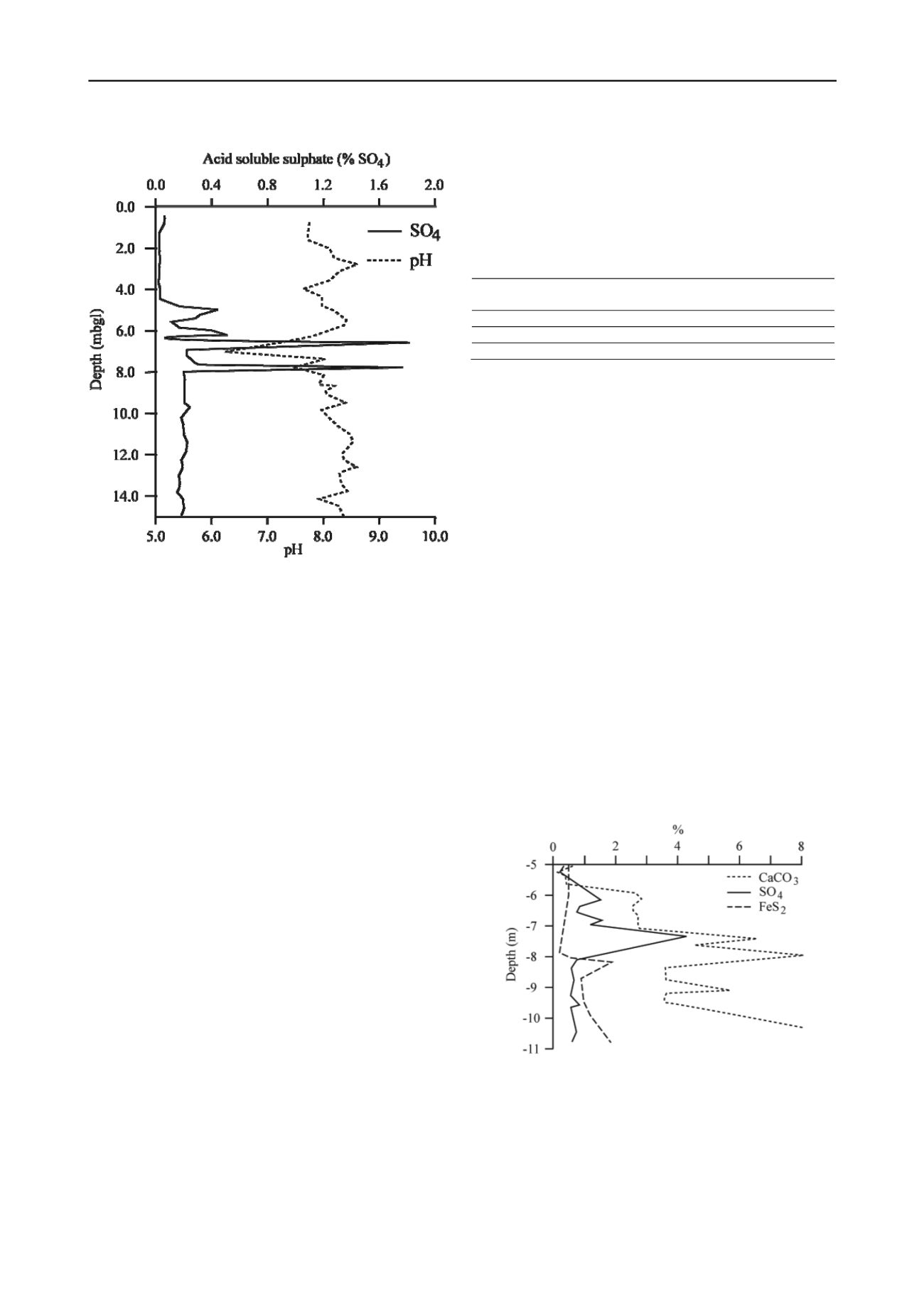
3105
Technical Committee 301 /
Comité technique 301
Figure 4. Sulphate and pH profile for the additional borehole at
Camberwell.
The results shown in Figure 4 can be summarised as follows:
a) To 4.5 m depth the clay is almost devoid of any sulphate,
below which there is a 2 m zone of minor sulphate peaks
b) A zone of sulphate enrichment is present at c. 6.5-8 m with
a maximum of 1.8 % SO
4
. This is over 2.5 times higher than
the peak in the original BH 2. This highlights the need for
an appreciation of the potential variation in sulphate
profiles, in this case from boreholes only 5 m apart
c) Below 8 m the AS is relatively constant at c. 0.2 % SO
4
5 ENGINEERING IMPLICATIONS
The significance of sulphates in the LCF has been appreciated
for many years such that in the 1930s the Institution of Civil
Engineers set up a research sub-committee to examine this,
although it was interrupted by the war years (Bessey and Lea,
1953). During their investigations, Bessey and Lea undertook
total sulphur and water soluble sulphate analyses, which until
the early 2000s was the common procedure. The determination
of acid soluble sulphate is now favoured, taking into
consideration the potential for acidic ground conditions to
develop. In addition, sulphate values were originally presented
as % SO
3
whereas % SO
4
is now used.
A well-known case study of concrete attack due to sulphate-
bearing ground is that of the St Helier Hospital in Surrey. The
750-bed hospital at Carshalton was constructed in 1938 and by
1959 it was found that some of the concrete foundations placed
in the brown LCF had seriously deteriorated. The remedial work
in the early 1960s involved supporting the hospital on piles
(Legget and Karrow, 1983).
5.1
Seasonal variation in sulphate concentration
Bessey and Lea noted the marked difference in sulphate values
taken in dry and wet conditions. For instance, following a very
dry summer/autumn, when measured in December the sulphate
values in two boreholes at Benfleet were as high as 0.30 % SO
4
.
However, following the wet winter, by March they had dropped
to 0.042-0.070 % SO
4
. Whilst the seasonal influence on the
shrink-swell of the LCF is well known, the effect on ground
sulphates is not appreciated by many geotechnical engineers.
Bessey and Lea also report sulphate contents taken from six
boreholes between three different depths where the average acid
soluble sulphate varied between 0.024-3.38 % SO
4
(Table 2).
Table 2. Difference in AS values given by Bessey & Lea (1953) with
averages of all six samples and of the highest two, which BRE (2005)
recommend should be taken as the characteristic value.
Depth (m)
Range,
SO
4
(%)
Avg. six samples,
SO
4
(%)
BRE avg. top
two, SO
4
(%)
0.3-0.9
0.024-0.372
0.1
0.22
0.9-1.83
0.036-0.516
0.23
0.44
1.83-2.74
0.444-3.38
0.78
1.99
Table 2 highlights the significance of appropriate sampling.
Although this has been in the literature for nearly 60 years, too
frequently samples are taken without due consideration of the
variation in sulphur/sulphate concentration with depth. Field
sampling should always take into account the depth at which it
is proposed to place concrete or steel in dark weathered clays.
Although Bessey & Lea draw attention to the fact that
gypsum is often present in the sandier horizons, this is also true
with calcareous/limestone bands which may become aerated in
dry periods, resulting in oxidation of the adjacent pyritic
mudrocks/clay.
5.2
Harrow on the Hill
Raison (1992) indicated the boundary of the LCF/Woolwich
and Reading Beds Formation (Lambeth Group) was at 35.5 m
AOD at Harrow. The relatively low liquid limit (c. 50 %) and a
moisture content below the plastic limit at the base of the LCF
are consistent with the presence of a silty-sandy horizon – the
Basement Beds. Although Raison shows the groundwater level
obtained during the investigation period to be at 50 m AOD (15
m deep) attention is not drawn to the difficulty of obtaining a
realistically quick piezometric response in clay-rich soils.
Detailed logging of continuous U
100
samples from a
supplementary borehole at Harrow on the Hill indicated the
brown LCF to some 7 m has selenite crystals up to 10 mm long
below which is a 1 m mottled horizon in which selenite crystals
of around 6 mm length are present. Chemical analyses of the
borehole samples gave the results in Figure 5.
Figure 5. Borehole chemistry at Harrow on the Hill.
The results can be summarised as follows:
a) To a depth of 7.5 m the pyrite content is relatively low (0.2 -
0.5 %). Below 8 m the pyrite content is > 0.75 % with a
peak of 1.8 % at 8.5 m depth
b) The calcite content is low to a depth of 6 m – frequently
< 0.5 %. Although it rises to 2.5 % between 6 and 7 m, the
main rise to 5-8 % is below 7 m


